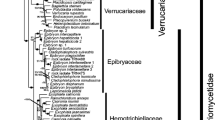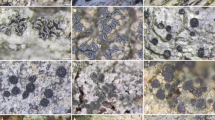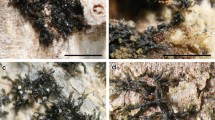Abstract
Phylogenetic relationships of Erysiphales within Ascomycota were inferred from the newly determined sequences of the 18S rDNA and partial sequences of the 28S rDNA including the D1 and D2 regions of 10 Erysiphales taxa. Phylogenetic analyses revealed that the Erysiphales form a distinct clade among ascomycetous fungi suggesting that the Erysiphales diverged from a single ancestral taxon. The Myxotrichaceae of the Onygenales was distantly related to the other onygenalean families and was the sister group to the Erysiphales calde, with which it combined to form a clade. The Erysiphales/Myxotrichaceae clade was also closely related to some discomycetous fungi (Leotiales, Cyttariales and Thelebolaceae) including taxa that form cleistothecial ascomata. The present molecular analyses as well as previously reported morphological observations suggest the possible existence of a novel evolutionary pathway from cleistothecial discomycetous fungi to Erysiphales and Myxotrichaceae. However, since most of these fungi, except for the Erysiphales, are saprophytic on dung and/or plant materials, the questions of how and why an obligate biotroph like the Erysiphales radiated from the saprophytic fungi remain to be addressed. We also estimated the radiation time of the Erysiphales using the 18S rDNA sequences and the two molecular clockes that have been previously reported. The calculation showed that the Erysiphales split from the Myxotrichaceae 190–127 myr ago. Since the radiation time of the Erysiphales does not exceed 230 myr ago, even when allowance is made for the uncertainty of the molecular clocks, it is possible to consider that the Erysiphales evolved after the radiation of angiosperms. The results of our calculation also showed that the first radiation within the Erysiphales (138–92 myr ago) coincided with the date of a major diversification of angiosperms (130–90 myr ago). These results may support our early assumption that the radiation of the Erysiphales coincided with the evolution of angiosperm plants.
Similar content being viewed by others
Literature cited
Adachi, J. and Hasegawa, M. 1996. MOLPHY: programs for molecular phylogenetics, ver. 2.3. Institute of Statistical Mathematics, Tokyo.
Ainsworth, G. C., James, P. W. and Hawksworth, D. L. 1971. Ainsworth and Bisby’s dictionaly of the fungi including the lichens. 6th ed. CAB International, Kew.
Alexopoulos, C. J. and Mims, C. W. 1979. Introductory mycology, 3rd ed. John Wiley & Sons, New York.
Amano (Hirata), K. 1986. Host range and geographical distribution of the powdery mildew fungi. Japan Scientific Societies Press. Tokyo.
Berbee, M. L. and Taylor, J. W. 1993. Dating the evolutionary radiation of the true fungi. Can. J. Bot.71: 1114–1127.
Braun, U. 1987. A monograph of the Erysiphales (powdery mildews). Beih. Nova Hedwig.89: 1–700.
Cain, R. F. 1972. Evolution of the fungi. Mycologia64: 1–14.
Cooke, J. C. and Barr, M. E. 1964. The taxonomic position of the genusThelebolus. Mycologia56: 763–769.
Crane, P. R., Friis, E. M. and Pedersen, K. R. 1995. The origin and early diversification of angiosperms. Nature374: 27–33.
Crumlish, B. and Curran, P. 1994.Amylocarpus encephaloides Currey, a marine fungus new to Ireland. Mycologist8: 83–84.
Currah, R. S. 1985. Taxonomy of the Onygenales: Arthrodermatacaae, Gymnoascaceae, Myxotrichacaea and Onygenaceae. Mycotaxon24: 1–216.
Currah, R. S. 1995. Ecological data and the systematics of the Onygenales. 3rd Intern. Symp. Mycol. Soc. Japan, Chiba, Japan, Nov. 30–Dec. 1, pp. 68–72.
Felsenstein, J. 1985. Confidence limits on phylogenies: an approach using the bootstrap. Evolution39: 783–791.
Felsenstein, J. 1989. PHYLIP-phylogeny inference package (version 3.2). Cladistics5: 164–166.
Hawksworth, D. L., Kirk, P. M., Sutton, B. C. and Pegler, D. N. 1995. Ainsworth & Bisby’s dictionary of the fungi. 8th ed. CAB Interntiona, Kew.
Higgins, D. G., Bleaby, A. J. and Fuchs, R. 1992. CLUSTAL V: improved software for multiple sequence alignment. Comput. Appl. Biosci.8: 189–191.
Hirata, T. and Takamatsu, S. 1996. Nucleotide sequence diversity of rDNA internal transcribed spacers extracted from conidia and cleistothecia of several powdery mildew fungi. Mycoscience37: 265–270.
Hiura, U. 1978. Genetic basis of formae speciales inErysiphe graminis DC. In: The powdery mildews, (ed. by Spencer, D. M.), pp. 101–128. Academic Press, New York.
Kimbrough, J. W. 1981. Cytology, Ultrastructure, and taxonomy ofThelebolus (Ascomycetes). Mycologia73: 1–27.
Kimura, M. 1980. A simple method for estimating evolutionary rates of base substitutions through comparative studies of nucleotide sequences. J. Mol. Evol.16: 111–120.
Kohlmeyer, J. and Kohlmeyer, E. 1979. Marine mycology: The higher fungi, Academic Press, New York.
Landvik, S., Egger, K. N. and Schumacher, T. 1997. Towards a subordinal classification of the Pezizales (Ascomycota): phylogenetic analyses of SSU rDNA sequences. Nord. J. Bot.17: 403–418.
Landvik, S., Kristiansen, R. and Schumacher, T. 1998. Phylogenetic and structural studies in the Thelebolaceae (Ascomycota). Mycoscience39: 49–56.
Landvik, S., Shailer, N. F. J. and Eriksson, O. E. 1996. SSU rDNA sequence support for a close relationship between the Elaphomycetales and the Eurotiales and Onygenales. Mycoscience37: 237–241.
Maddison, W. P. and Maddison, D. R. 1992. MacClade: Analysis of Phylogeny and Character Evolution. Sunderland, MA: Sinauer Associates, Inc.
Momol, E. A., Kimbrough, J. W. and Eriksson, O. E. 1996. Phylogenetic relationships ofThelebolus indicated by 18S rDNA sequence analyses. Syst. Ascom.14: 91–100.
Mori, Y., Sato, Y. and Takamatsu, S. 2000. Evolutionary analysis of the powdery mildew fungi (Erysiphales) using nucleotide sequences of the nuclear ribosomal DNA. Mycologia92: 74–93.
Nomura, Y. 1997. Taxonomical study of Erysiphaceae of Japan. Yokendo, Tokyo. (In Japanese.)
Pirozynski, K. A. 1976. Fossil fungi. Annu. Rev. Phytopathol.14: 237–246.
Saenz, G. S. and Taylor, J. W. 1999. Phylogeney of the Erysiphales (powdery mildews) inferred from internal transcribed spacer (ITS) ribosomal DNA sequences. Can. J. Bot.77: 150–169.
Saenz, G. S., Taylor, J. W. and Gargas, A. 1994. 18S rRNA gene sequences and supraordinal classification of the Erysiphales. Mycologia86: 212–216.
Saitou, N. and Nei, M. 1987. The neighbor-joining method: a new method for reconstructing phylogenetic trees. Mol. Biol. Evol.4: 406–425.
Samuelson, D. A. and Kimbrough, J. W. 1978. Asci of the Pezizales IV: The apical apparatus ofThelebolus. Bot. Gaz.139: 346–361.
Savard, L., Li, P., Strauss, S. H., Chase, M. W., Michaud, M. and Bousquet, J. 1994. Chloroplast and nuclear gene sequences indicate Late Pennsylvanian time for the last common ancestor of extant seed plants. Proc. Nat. Acad. Sci. USA91: 5163–5167.
Simon, L., Bousquet, J., Lévesque, R. C. and Lalonde, M. 1993. Origin and diversification of endomycorrhizal fungi and coincidence with vascular land plants. Nature363: 67–69.
Sugiyama, M., Ohara, A. and Mikawa, T. 1999. Molecular phylogeny of onygenalean fungi based on small subunit ribosomal DNA (SSU rDNA) sequences. Mycoscience40: 251–258.
Swofford, D. L. 1993. Phylogenetic Analysis Using Parsimony (PAUP Version 3.1.1.). Illnois Natural History Survey: Champaign, Illinois.
Tajima, F. 1993. Simple methods for testing the molecular evolutionary clock hypothesis. Genetics135: 599–607.
Takamatsu, S., Hirata, T. and Sato, Y. 1998. Phylogenetic analysis and predicted secondary structures of the rDNA internal transcribed spacers of the powdery mildew fungi (Erysiphaceae). Mycoscience39: 441–453.
Tiffney, B. H. and Barghoorn, E. S. 1974. The fossil record of the fungi. Occas. Pap. Farlow Herb. Cryptogam. Bot. Harv.7: 1–42.
Walsh, P. S., Metzger, D. A. and Higuchi, R. 1991. Chelex 100 as a medium for simple extraction of DNA for PCR-based typing from forensic material. Bio Techniques10: 506–513.
Webster, J. 1980. Introduction of fungi. 2nd ed. Cambridge University Press. New York.
White, T. J., Bruns, T. D., Lee, S. and Taylor, J. 1990. Amplification and direct sequencing of fungal ribosomal genes for phylogenetics. In: PCR protocols: a guide to methods and applications, (ed. by Innis, M. A., Gelfand, D. H., Sninsky, J. J. and White, T. J.), pp. 315–322. Academic Press, San Diego.
Yarwood, C. E. 1957. Powdery mildews. Bot. Rev.13: 235–301.
Yarwood, C. E. 1973. Pyrenomycetes: Erysiphales. In: The fungi: an advanced treatise. Vol. IVA, (ed. by Ainsworth, G. C., Sparrow, F. K. and Sussman, A. S.), pp. 71–86. Academic Press, New York.
Yarwood, C. E. 1978. History and taxonomy of the powdery mildews. In: The powdery mildews, (ed. by Spencer, D. M.), pp. 1–37. Academic Press, New York.
Zukal, H. 1886. Mykologische Untersuchungen. Demkschriften der Akademie der Wissenschaften (Wien), Math.-Naturw.51: 21–36.
Author information
Authors and Affiliations
Corresponding author
Additional information
Contribution No. 152 from the Laboratory of Plant Pathology, Mie University
About this article
Cite this article
Mori, Y., Sato, Y. & Takamatsu, S. Molecular phylogeny and radiation time of Erysiphales inferred from the nuclear ribosomal DNA sequences. Mycoscience 41, 437–447 (2000). https://doi.org/10.1007/BF02461662
Accepted:
Issue Date:
DOI: https://doi.org/10.1007/BF02461662




